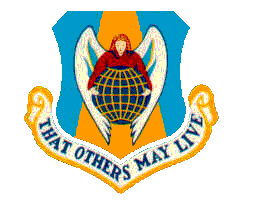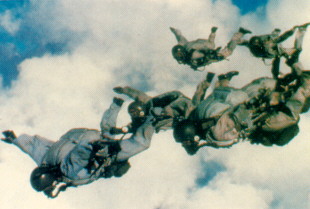| U.S.A.F. Pararescue | |
|---|---|

| 
|
| U.S.A.F. Pararescue | |
|---|---|

| 
|
The U.S.A.F. Pararescue teams are tasked with search and rescue missions into a wide variety or terrains and regions. Their missions include:
After the Air Force became its own separate entity in 1947, five pararescue teams were formed. By 1952 the Air Force could deploy 45 seven-man teams globally as part of the ARCS (Air Resupply and Communications Service). The Pararescue teams operated during the Korean War. In one case a British pilot who had crashed 75 miles behind enemy lines was pulled from his aircraft and carried back to a waiting helicopter. This despite the fact that he out-weighed the Paradoctor by 40 pounds and they were under intense small-arms fire (although this could have provided a lot of motivation!).
During the late 1950s the Air Force began to downsize the Pararescue teams. This did not stop them from developing many of the paraSCUBA techniques used the world over today. It was at this time that the Para rescue teams began operating with NASA, an arrangement that has lead to their current assignment as NASA Space Shuttle launch support. During this period they also made many top secret deployments, possibly to S.E. Asia in support of Army Special Forces projects.
The Vietnam War was a pivotal conflict for the Pararescue teams. The Air Force's scope of operations became so large that demand for Pararescue teams expanded as well. The use of helicopters caused new tactics utilizing the speed, distance, and support they could provide. Rescue "packages" were created utilizing FACs (Forward Air Controllers), rescue escorts (such as AH-1 Cobras or A-1 Sandys), protective fighter CAP (Combat Air Patrol), and of course, the HH-53 Jolly Green helicopter.
Pararescue team members would be inserted to conduct LSO (Limited Surface Operations) searches while the escorts maintained an aggressive patrol to provide instantaneous support. Sometimes they would be inserted to search for personnel who were being forced to escape and evade; in such cases the mission might last for days. During the Vietnam War only 19 Airmen were awarded the Air Force Cross. Ten of those were awarded to Pararescuemen.
This page is copywritten by Tracy White 1998. I don't care if you read or use the information here but PLEASE don't rip it off.